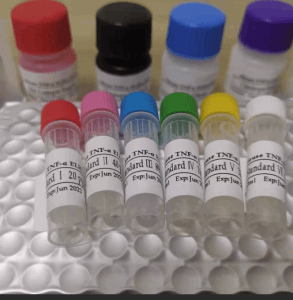促甲状腺素受体抗体(C端)
- 发布日期: 2025-03-19
- 更新日期: 2025-11-19
产品详请
| 产地 |
中国
|
| 品牌 |
雅吉生物
|
| 保存条件 |
-20
|
| 货号 |
YS-0206R
|
| 用途 |
|
| 应用范围 |
|
| 抗原来源 |
Rabbit
|
| 保质期 |
|
| 抗体名 |
|
| 是否单克隆 |
|
| 克隆性 |
否
|
| 靶点 |
详见説明
|
| 适应物种 |
Rabbit
|
| 形态 |
|
| 宿主 |
|
| 标记物 |
|
| 包装规格 |
50ul,100ul,200ul
|
| 亚型 |
IgG
|
| 标识物 |
|
| 浓度 |
1mg/ml%
|
| 免疫原 |
|
| 是否进口 |
|
英文名称Rabbit Anti-TSHR (CT) antibody
中文名称促甲状腺素受体抗体(C端)
别 名hTSHR I; hTSHRI; LGR 3; LGR3; MGC75129; Thyroid adenoma hyperfunctioning; Thyroid carcinoma with thyrotoxicosis; Thyroid Stimulating Hormone Receptor; Thyrotropin Receptor; Thyrotropin receptor I; TSH R; TSHR; Thyroid stimulating hormone receptor; TSHR_HUMAN. 促甲状腺激素受体
抗体来源Rabbit
克隆类型Polyclonal
交叉反应Human (predicted: Rat,Rabbit,Pig,Cow,Chicken,GuineaPig,Horse)
产品应用WB=1:500-2000,IHC-P=1:100-500,IHC-F=1:100-500,IF=1:100-500
not yet tested in other applications.
optimal dilutions/concentrations should be determined by the end user.
理论分子量86kDa
细胞定位细胞膜
性 状Liquid
浓 度1mg/ml
免 疫 原KLH conjugated synthetic peptide derived from human TSHR: 648-740/764
亚 型IgG
纯化方法affinity purified by Protein A
缓 冲 液0.01M TBS (pH7.4) with 1% BSA, 0.02% Proclin300 and 50% Glycerol.
保存条件Shipped at 4℃. Store at -20℃ for one year. Avoid repeated freeze/thaw cycles.
注意事项This product as supplied is intended for research use only, not for use in human, therapeutic or diagnostic applications.
PubMedPubMed
产品介绍The glycoprotein hormone receptor family consists of the luteinizing hormone receptor, the follicle-stimulating hormone receptor, and the thyroid stimulating hormone(TSH) receptor. TSH, which is released from the pituitary gland, binds to the TSH receptor on thyroid cells to control size and function of the thyroid gland (De Felice et al. 2004). The TSH receptor signals through Gs to elevate intracellular cAMP in the thyroid gland, which regulates iodide uptake, and transcription of thyroglobulin (Tg), thyroid peroxidase (TPO), and sodium-iodide symporter. The TSH receptor also signals Gq and phospholipase C to regulat iodide efflux, H2O2 production, and thyroglobulin iodination. Autoimmunity to the TSH receptor causes hyperthyroidism (Graves disease) or hypothyroidism (Hashimoto thyroiditis) when the autoantibodies function as agonists or antagonists, respectively, at the TSH receptor (Rapoport and McLachlan, 2001; Davies et al., 2002). Millipore’s cloned human TSH receptor-expressing cell line is made in the Chem-10 host, which supports high levels of recombinant TSH receptor expression on the cell surface and contains high levels of the promiscuous G protein to couple the receptor to the calcium signaling pathway. Thus, the cell line is an ideal tool for screening for antagonists of interactions between TSH and its ligands.
Function:
Receptor for thyrothropin. Plays a central role in controlling thyroid cell metabolism. The activity of this receptor is mediated by G proteins which activate adenylate cyclase. Also acts as a receptor for thyrostimulin (GPA2+GPB5).
Subunit:
Interacts (via the PDZ-binding motif) with SCRIB; regulates TSHR trafficking and function.
Subcellular Location:
Cell membrane; Multi-pass membrane protein.
Tissue Specificity:
Expressed in the thyroid.
DISEASE:
Note=Defects in TSHR are found in patients affected byhyperthyroidism with different etiologies. Somatic, constitutivelyactivating TSHR mutations and/or constitutively activatingG(s)alpha mutations have been identified in toxic thyroid nodules (TTNs) that are the predominant cause of hyperthyroidism in iodinedeficient areas. These mutations lead to TSH independent activationof the cAMP cascade resulting in thyroid growth and hormoneproduction. TSHR mutations are found in autonomously functioning nodules (AFTN), toxic multinodular goiter (TMNG) and hyperfunctioning thyroid adenomas (HTA). TMNG encompasses a spectrum of different clinical entities, ranging from a single hyperfunctioning nodule within an enlarged thyroid, to multiple hyperfunctioning areas scattered throughout the gland. HTA are discrete encapsulated neoplasms characterized by TSH-independent autonomous growth, hypersecretion of thyroid hormones, and TSH suppression. Defects in TSHR are also a cause of thyroid neoplasms (papillary and follicular cancers).
Note=Autoantibodies against TSHR are directly responsible for the pathogenesis and hyperthyroidism of Graves disease. Antibody interaction with TSHR results in an uncontrolled receptor stimulation.
Hypothyroidism, congenital, non-goitrous, 1 (CHNG1) [MIM:275200]: A non-autoimmune condition characterized by resistance to thyroid-stimulating hormone (TSH) leading to increased levels of plasma TSH and low levels of thyroid hormone. It presents variable severity depending on the completeness of the defect. Most patients are euthyroid and asymptomatic, with a normal sized thyroid gland. Only a subset of patients develop hypothyroidism and present a hypoplastic thyroid gland. Note=The disease is caused by mutations affecting the gene represented in this entry.
Familial gestational hyperthyroidism (HTFG) [MIM:603373]: A condition characterized by abnormally high levels of serum thyroid hormones occurring during early pregnancy. Note=The disease is caused by mutations affecting the gene represented in this entry.
Hyperthyroidism, non-autoimmune (HTNA) [MIM:609152]: A condition characterized by abnormally high levels of serum thyroid hormones, thyroid hyperplasia, goiter and lack of anti-thyroid antibodies. Typical features of Graves disease such as exophthalmia, myxedema, antibodies anti-TSH receptor and lymphocytic infiltration of the thyroid gland are absent. Note=The disease is caused by mutations affecting the gene represented in this entry.
Similarity:
Belongs to the G-protein coupled receptor 1 family. FSH/LSH/TSH subfamily.
Contains 7 LRR (leucine-rich) repeats.
SWISS:
P16473
Gene ID:
7253

